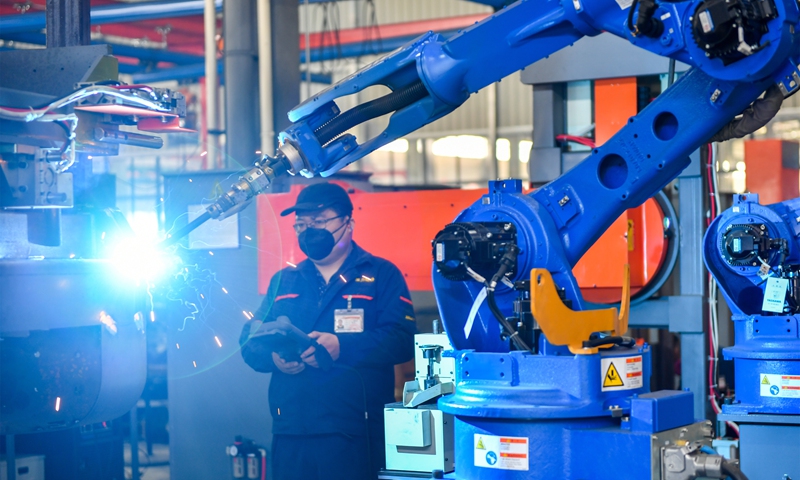
A worker controls an automated robot workstation operating at high speed in a digital workshop in Huzhou, East China's Zhejiang Province on November 30, 2021. Photo: VCG
After a period of confusing noise about China's "over-capacity," some Western media are slowly starting to return to reality. The Financial Times recently published an editorial titled "Chinese electric vehicles are more of an opportunity than a threat," stating that the US and Europe should welcome China to produce cost-effective cars in the cheapest segments to help achieve economic decarbonization. Even The Economist, which is often biased against China's economy, acknowledged China's growing role as the world's R&D lab. The magazine also noted that foreign CEOs now see China's brainpower and its innovation-curious regulatory regime are crucial ingredients of their companies' global success.
The recent hype about China's "over-capacity" began with the fear of the so-called China shock 2.0. Unfair subsidies and cheap dumping were the habitual accusations pinned on China's industries. However, these accusations were made too arbitrarily, and even the critics themselves are finding it difficult to explain why industries such as electric vehicles have gained an edge in China, or why China has become the world's R&D lab, as recently noted by The Economist. The deeper we look, the more we find the absurdity of blaming China's industrial development.
In recent years, it has become common for foreign companies to set up R&D centers in China and engage in technological research and product innovation. Apple has R&D centers in Beijing, Shanghai, Shenzhen and Suzhou, with its R&D staff in China doubling over the past five years. BMW has established its largest global production base and the largest R&D system outside Germany in China. BASF's innovation campus in Shanghai is the largest in the Asia-Pacific region and the second-largest globally. In February this year, British pharmaceutical company AstraZeneca announced plans to transform its Shanghai operations into a global R&D hub. The choice of China as an R&D hub by many Western companies actually reflects the deeper reasons behind China's outstanding performance in the current global industrial innovation landscape.
China's industrial development ultimately relies on a large pool of high-quality talent, market competition, innovation capability, and the strategic resolve of "sticking to a single blueprint until the end." In terms of talent alone, China produces seven times more engineering degree holders than the US, 2.5 times more top-tier AI researchers at the undergraduate level, and it is projected that by 2025, China will produce almost twice as many science and technology PhD graduates as the US. Of course, China's industrial development and technological innovation advantages haven't been achieved overnight, but are the result of extensive efforts and accumulation. Since 2000, China's R&D expenditure has increased over 30-fold, with last year's R&D investment exceeding 3.3 trillion yuan. Often, the significant cost advantages that Chinese products achieve in the market far surpass their competitors, and this is the result of full-industry chain innovation in a competitive market environment.
It is essential to recognize that China has established a robust technological market and a competitive atmosphere. Leveraging its vast domestic market and industrial base, significant technological markets have emerged in places like Shanghai and Hefei, Anhui Province, achieving notable progress in fields such as intelligent manufacturing and new materials. Whether in terms of market competition or innovation regulation, China's technological market stands out globally. The rapid advancements in cutting-edge technological fields such as autonomous driving and AI in China are closely linked to this conducive environment.
In fact, China has consistently maintained an attitude of open cooperation and mutual benefit in promoting technological innovation in frontier fields and industrial innovation in practical applications. Take new energy as an example: China is the largest contributor to global energy transition investments, accounting for half of the total global investment. China's goal of achieving its own energy transition is resolute, and it also aims to support the global green and low-carbon transition through the development of its new energy industry. Creating artificial political barriers will not suppress China's development and runs counter to the mainstream understanding in the scientific and business communities, harming the interests of the entire world. As the Financial Times stated, at some point, Western leaders will have to choose between their climate goals and their protectionism - and it would be better for everyone if it is protectionism that has to give.




